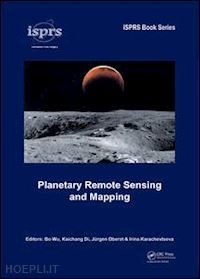SECTION I: REFERENCE SYSTEMS OF PLANETARY BODIES Chapter 1 A technical framework for construction of new-generation lunar global control network using multi-mission data K. Di, B. Liu, M. Peng, X. Xin, M. Jia, W. Zuo, J. Ping, B. Wu and J. Oberst Chapter 2 Basic geodetic and dynamical parameters of Saturn’s moon Enceladus: A key target of future exploration A. Stark, H. Hussmann, J. Oberst, B. Giese, F. Sohl, D. Shoji, K. Wickhusen and M. Wählisch Chapter 3 On the applicability of physically defined height systems for telluric planets and moons R. Tenzer and I. Foroughi SECTION II: PLANETARY EXPLORATION MISSIONS AND SENSORS Chapter 4 Comet 67P/Churyumov-Gerasimenko through the eyes of the Rosetta/OSIRIS cameras C. Güttler and the OSIRIS Team Chapter 5 The BepiColombo Laser Altimeter (BELA): An instrument for geodetic investigations of Mercury H. Hussmann, J. Oberst, A. Stark, G. Steinbrügge Chapter 6 Mars orbit optical remote sensor: High- and medium-resolution integrated stereo camera Q. Meng, D. Wang and J. Dong Chapter 7 Mission profile and design challenges of Mars landing exploration J. Dong, Z. Sun, W. Rao, Y. Jia, C. Wang, B. Chen and Y. Chu SECTION III: GEOMETRIC INFORMATION EXTRACTION FROM PLANETARY REMOTE SENSING DATA Chapter 8 Correcting spacecraft jitter in HiRISE images S. S. Sutton, A. K. Boyd, R. L. Kirk, D. Cook, J. W. Backer, A. Fennema, R. Heyd, A. S. McEwen and S. D. Mirchandani Chapter 9 Community tools for cartographic and photogrammetric processing of Mars Express HRSC images R. L. Kirk, E. Howington-Kraus, K. Edmundson, B. Redding, D. Galuszka, T. Hare and K. Gwinner Chapter 10 Photogrammetric processing of LROC NAC images for precision lunar topographic mapping B. Wu, H. Hu and W. C. Liu Chapter 11 Mercury stereo topographic mapping using data from the MESSENGER orbital mission F. Preusker, J. Oberst, A. Stark and S. Burmeister SECTION IV: FEATURE INFORMATION EXTRACTION FROM PLANETARY REMOTE SENSING DATA Chapter 12 Automatic crater detection for mapping of planetary surface age A. L. Salih, A. Lompart, P. Schulte, M. Mühlbauer, A. Grumpe, C. Wöhler and H. Hiesinger Chapter 13 Small craters on the Moon: Focus on Tycho’s crater rays R. Bugiolacchi Chapter 14 Elemental and topographic mapping of lava flow structures in Mare Serenitatis on the Moon A. Grumpe, C. Wöhler, D. Rommel, M. Bhatt and U. Mall Chapter 15 Mineral abundance and particle size distribution derived from in situ spectra measurements of the Chang’E-3 Yutu rover H. Lin, X. Zhang, X. Wu, Y. Yang and D. Guo SECTION V: PLANETARY REMOTE SENSING DATA FUSION Chapter 16 Fusion of multi-scale DEMs from Chang’E-3 descent and Navcam images using compressed sensing method M. Peng, W. Wen, Z. Liu and K. Di Chapter 17 Co-registration of lunar imagery and digital elevation model constrained by both geometric and photometric information B. Liu, X. Xin, K. Di, M. Jia and J. Oberst Chapter 18 Co-registration of multiple-source DEMs for correlated slope analysis at different scales on Mars Y. Wang and B. Wu SECTION VI: PLANETARY DATA MANAGEMENT AND PRESENTATION Chapter 19 Status and future developments in planetary cartography and mapping A. Naß, K. Di, S. Elgner, S. van Gasselt, T. Hare, H. Hargitai, I. Karachevtseva, E. Kersten, N. Manaud, T. Roatsch, A. P. Rossi, J. Skinner, Jr. and M. Wählisch Chapter 20 The lunar sub-polar areas: Morphometric analysis and mapping A.A. Kokhanov, I.P. Karachevtseva, N.A. Kozlova and Zh.F. Rodionova Chapter 21 Geoportal of planetary data: Concept, methods and implementations I. P. Karachevtseva, A. S. Garov, A. E. Zubarev, E. V. Matveev, A. A. Kokhanov and A. Yu. Zharkova











